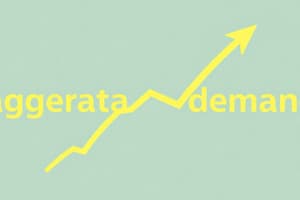Podcast
Questions and Answers
What are the four stages of the economic cycle?
What are the four stages of the economic cycle?
- Expansion, peak, contraction, trough (correct)
- Contraction, trough, expansion, peak
- Peak, inflation, recession, unemployment
- Peak, contraction, inflation, expansion
Which macroeconomic goal involves a long-term increase in real GDP per capita?
Which macroeconomic goal involves a long-term increase in real GDP per capita?
- Promoting economic growth (correct)
- Balancing inflation and unemployment
- Maintaining stable exchange rates
- Achieving sustainable development
What does inflation measure in an economy?
What does inflation measure in an economy?
- Unemployment rate variation
- Trade balance fluctuations
- Rise in the general price level (correct)
- Increase in real GDP per capita
What is the key challenge for policymakers regarding inflation and unemployment?
What is the key challenge for policymakers regarding inflation and unemployment?
What do exchange rates represent in macroeconomics?
What do exchange rates represent in macroeconomics?
What is the main objective of sustainable development?
What is the main objective of sustainable development?
What is the role of aggregate demand (AD) in macroeconomics?
What is the role of aggregate demand (AD) in macroeconomics?
What is the equilibrium price and quantity in macroeconomics?
What is the equilibrium price and quantity in macroeconomics?
How does monetary policy impact the economy?
How does monetary policy impact the economy?
What is the primary objective of fiscal policy in macroeconomics?
What is the primary objective of fiscal policy in macroeconomics?
Which concept signifies the total amount of goods an economy can produce at different price levels?
Which concept signifies the total amount of goods an economy can produce at different price levels?
In macroeconomics, what happens at the 'full employment level' or 'potential GDP'?
In macroeconomics, what happens at the 'full employment level' or 'potential GDP'?
Study Notes
Macroeconomics: Unraveling the Big Picture of Economy
Macroeconomics, a branch of economics, focuses on the large-scale view of a nation's economy: the behavior of aggregate variables like GDP, unemployment, inflation, and interest rates. To understand its pivotal role in shaping our societies, let's explore the theories and concepts that inform this vital field.
Aggregate Demand and Supply
Central to macroeconomics is the interplay between aggregate demand (AD) and aggregate supply (AS). AD represents the total demand for final goods and services in an economy, whereas AS signifies the total amount of such goods and services our economy can produce at different price levels. The equilibrium price and quantity occur when AD equal AS, also known as the "full employment level" or "potential GDP."
Macroeconomic Policy
Governments and central banks employ various macroeconomic policies, such as fiscal policy and monetary policy, to manage the economy and achieve specific objectives.
-
Fiscal Policy: This policy involves the government's use of tools like taxation and public expenditure to stabilize the economy, increase employment, and control inflation.
-
Monetary Policy: This policy refers to the government's manipulation of interest rates, the money supply, and other monetary measures to achieve economic goals.
Business Cycle and Economic Growth
Macroeconomics examines the economy's fluctuations over time, known as the business cycle. This cycle encompasses four stages: expansion, peak, contraction, and trough. A key macroeconomic goal is to promote economic growth, which refers to the long-term increase in real GDP per capita over time.
Inflation and Unemployment
Inflation and unemployment are two essential macroeconomic variables. Inflation is the rate at which the general price level rises over time, while unemployment refers to the number of people actively seeking employment but unable to find work. A major challenge to policymakers is finding the right balance between inflation and unemployment, known as the "Phillips curve trade-off."
International Trade and Exchange Rates
Macroeconomics also emphasizes the interplay between countries' economies through international trade and exchange rates. Exchange rates represent the price of one country's currency in terms of another country's currency. This relationship affects trade, investment, and the balance of payments.
Sustainable Development
Finally, macroeconomics acknowledges the importance of sustainable development, which addresses the economic, social, and environmental concerns of our planet. Sustainable development aims to meet current needs without compromising the ability of future generations to satisfy their needs.
In summary, macroeconomics is a vital discipline that studies the big-picture economic phenomena affecting our societies. It informs governments and central banks about the effectiveness of various policies, helps us understand the interplay of global economies, and offers insights into sustainable development. With its focus on aggregate variables and complex interactions, macroeconomics provides a holistic perspective on our economies, giving us a better grasp of our world's economic landscape.
Studying That Suits You
Use AI to generate personalized quizzes and flashcards to suit your learning preferences.
Description
Test your knowledge on key concepts in macroeconomics such as aggregate demand and supply, macroeconomic policies, business cycles, inflation, unemployment, international trade, exchange rates, and sustainable development. Explore the fundamental principles that underpin the study of a nation's economy.



